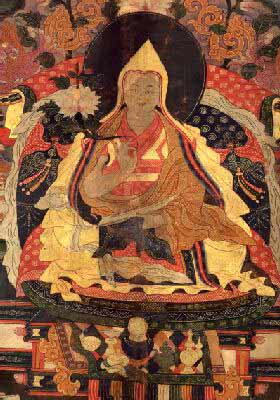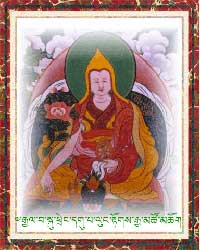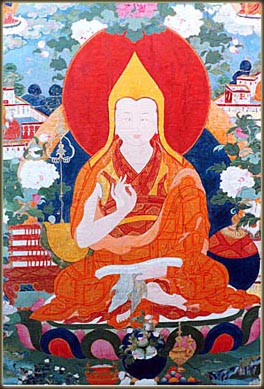11:19

Khol Lesson 12 Part 1 of 3: Introduction to Tiśra Jāti Tālas
This lesson begins a new series of rhythmic cycles. The rhythmic cycles presented in Lesso...
published: 15 Jul 2011
author: KrsnaKirtanaSongs
Khol Lesson 12 Part 1 of 3: Introduction to Tiśra Jāti Tālas
This lesson begins a new series of rhythmic cycles. The rhythmic cycles presented in Lessons 12, 13, and 14 will be of cycles based on multiples of 3, known as tiśra jāti. From Lessons 6 though 11, rhythmic cycles based on multiples of 4 were discussed, thus being classified as cataśra jāti. This lesson talks about the tiśra jāti in some detail before introduction of the first cycle in Lesson 12 - 2. kksongs.org
published: 15 Jul 2011
views: 349
8:24

พระเวสสันดร The End/2 Jataka Sub. 中文Eng
www.dmc.tv พระเวสสันดร ผู้ยิ่งด้วยทานบารมี The Jātaka Tales (Sanskrit जातक) also known in ...
published: 08 Mar 2010
author: buddhisttales
พระเวสสันดร The End/2 Jataka Sub. 中文Eng
www.dmc.tv พระเวสสันดร ผู้ยิ่งด้วยทานบารมี The Jātaka Tales (Sanskrit जातक) also known in other languages (Malay jetaka, Burmese: zataka, Lao: ຊາດົກ sadok, Thai: ชาดก chadok, Khmer: ជាតក cietɑk) refer to a voluminous body of folklore-like literature native to India concerning the previous births (jāti) of the Buddha. The word most specifically refers to a text division of the Pali Canon of Theravada Buddhism, included in the Khuddaka Nikaya of the Sutta Pitaka. Jataka also refers to the traditional commentary on this book. Channel Description:The Jātaka Tales (Sanskrit जातक) also known in other languages (Malay: jetaka, Burmese: zataka, Lao: ຊາດົກ sadok, Thai: ชาดก chadok, Khmer: ជាតក cietɑk) refer to a voluminous body of folklore-like literature native to India concerning the previous births (jāti) of the Buddha. The word most specifically refers to a text division of the Pali Canon of Theravada Buddhism, included in the Khuddaka Nikaya of the Sutta Pitaka. Jataka also refers to the traditional commentary on this book. The Jātaka Tales (Sanskrit जातक) also known in other languages (Malay: jetaka, Burmese: zataka, Lao: ຊາດົກ sadok, Thai: ชาดก chadok, Khmer: ជាតក cietɑk) refer to a voluminous body of folklore-like literature native to India concerning the previous births (jāti) of the Buddha. The word most specifically refers to a text division of the Pali Canon of Theravada Buddhism, included in the Khuddaka Nikaya of the Sutta ...
published: 08 Mar 2010
author: buddhisttales
views: 2230
0:26

สื่อธรรมะ
www.dmc.tv พระเวสสันดร ผู้ยิ่งด้วยทานบารมี The Jātaka Tales (Sanskrit जातक) also known in ...
published: 02 Jul 2010
author: buddhisttales
สื่อธรรมะ
www.dmc.tv พระเวสสันดร ผู้ยิ่งด้วยทานบารมี The Jātaka Tales (Sanskrit जातक) also known in other languages (Malay jetaka, Burmese: zataka, Lao: ຊາດົກ sadok, Thai: ชาดก chadok, Khmer: ជាតក cietɑk) refer to a voluminous body of folklore-like literature native to India concerning the previous births (jāti) of the Buddha. The word most specifically refers to a text division of the Pali Canon of Theravada Buddhism, included in the Khuddaka Nikaya of the Sutta Pitaka. Jataka also refers to the traditional commentary on this book. Channel Description:The Jātaka Tales (Sanskrit जातक) also known in other languages (Malay: jetaka, Burmese: zataka, Lao: ຊາດົກ sadok, Thai: ชาดก chadok, Khmer: ជាតក cietɑk) refer to a voluminous body of folklore-like literature native to India concerning the previous births (jāti) of the Buddha. The word most specifically refers to a text division of the Pali Canon of Theravada Buddhism, included in the Khuddaka Nikaya of the Sutta Pitaka. Jataka also refers to the traditional commentary on this book. The Jātaka Tales (Sanskrit जातक) also known in other languages (Malay: jetaka, Burmese: zataka, Lao: ຊາດົກ sadok, Thai: ชาดก chadok, Khmer: ជាតក cietɑk) refer to a voluminous body of folklore-like literature native to India concerning the previous births (jāti) of the Buddha. The word most specifically refers to a text division of the Pali Canon of Theravada Buddhism, included in the Khuddaka Nikaya of the Sutta ...
published: 02 Jul 2010
author: buddhisttales
views: 2037
7:04

Skyforger - Migla migla, Rasa rasa (Oh Fog, Oh Dew) Full
Skyforger - Migla migla, Rasa rasa.( Svētās vedības). Pērkoņkalve( Thunderforge) 2003. Ful...
published: 18 Mar 2009
author: elfofwoods
Skyforger - Migla migla, Rasa rasa (Oh Fog, Oh Dew) Full
Skyforger - Migla migla, Rasa rasa.( Svētās vedības). Pērkoņkalve( Thunderforge) 2003. Full verse. Migla, migla, rasa, rasa, Tās man labu nedarīj'- Rasā manas kājas mirka, Miglā nozūd kumeliņš Nokrīt migla, nokrīt rasa Atrod savu kumeliņ; Atrod savu kumeliņ Pie Mēneša namdurvīm Mēness ņēma Saules meitu, Aicin' mani vedībās, Kā es jāšu vedībāsi Nesedlotu kumeliņ' Saule deva zelta sedlus Mēness sudrab' iemauktiņs', Nu es varu droši jāti Dieva dēlu pulciņā Krustiem auga kokiem saknes, Krustiem zvaigznes debesīs, Sāniem jāja Dieva dēli, Krustiem tek'a kumeliņ'. Oh fog, oh dew Neither one was good for me The dew dampened my feet The fog made me lose my steed The fog lifted, the dew lifted I found my horse I found my horse At the Mēness's(Moon) doorstep The Mēness took the daughter of Saule(Sun) And invited me to a wedding How can I ride to a wedding On a horse without saddle? The Saule gave me a golden saddle The Mēness a silver bridle Now I can boldly ride Together with the sons of Dievs Crosswise grow the roots of trees Crosswise stars shine in the sky The sons of Dievs(god) ride next to me Crosswise galloping our horses
published: 18 Mar 2009
author: elfofwoods
views: 74924
4:53

AWAKENING - NIBBANA (Ven Dr Punnaji)
Ven Dr M. Punnaji explains AWAKENING - NIBBANA. Anekajātisaṁsāraṁ -- sandhāvissaṁ anibbisa...
published: 30 Aug 2012
author: streetwisdombilly
AWAKENING - NIBBANA (Ven Dr Punnaji)
Ven Dr M. Punnaji explains AWAKENING - NIBBANA. Anekajātisaṁsāraṁ -- sandhāvissaṁ anibbisaṁ Gahakārakaṁ gavesanto --dukkhā jāti punappunaṁ. Gahakāraka diṭṭho' si --puna gehaṁ na kāhasi Sabbā te phāsukā bhaggā --gahakūṭaṁ visaṅkhataṁ Visaṅkhāragataṁ cittaṁ --taṇhānaṁ khayam ajjhagā. (Dhammapada verses 153 & 154) QUOTE: (Translation by Ven Dr Punnaji) Through innumerable lives in this vortex of rebirth, did I seek the Creator of this grief ridden world. Never did I find this Creator unknown. It is painful to be born again and again. Oh, Creator, I have seen you! You will never create again! Your structure is dismantled, the foundation is destroyed; The mind has stopped creating -- the emotional urge has ceased. UNQUOTE This is how one awakens from the Dream of Existence to the Experience of Experience resulting in Liberation from Existence and Suffering (vimutti) and reverting to the Imperturbable Serenity Of Mind (akuppā-ceto-vimutti) that is NIBBĀNA.
published: 30 Aug 2012
author: streetwisdombilly
views: 167
4:24

TMA: Div' dūjiņas gaisā skrēja
Div' dūjiņas gaisā skrēja - łotewska pieśń, otwierająca koncert INTERMARIUM, który odbył s...
published: 09 Mar 2009
author: HallmannTV
TMA: Div' dūjiņas gaisā skrēja
Div' dūjiņas gaisā skrēja - łotewska pieśń, otwierająca koncert INTERMARIUM, który odbył się 8 marca AD 2009 w krakowskiej Chimerze. Skład: Walenty Dobrawski (Kijów) - pianino Dawid Hallmann (Tarnów/Śląsk) - gitara, I wokal Rafał Halski (Tarnów) - gitara, II wokal Div'dūjiņas gaisā skrēja, Abas skrēja dūdodam's. Ai, ai, aijajaijā Abas skrēja dūdodam's. Div' bāliņi karā jāja, Abi jāja domādam'. Vai būs jāti vai nejāti, Vai palikti šai zemē. Šai zemēi laba dzīve - Jaunas meitas gultu tais'. Kas taisija zaldātam'i, Kas tam klāja paladziņ'? Priežu zari, egļu skujas - Karavīra paladziņš. Sūnu cinis, akmentiņis - Karavīra spilventiņš.
published: 09 Mar 2009
author: HallmannTV
views: 5743
1:10

Nepali anthem - सयौं थूंगा फूलका
Nepali lyrics: सयौं थूंगा फूलका हामी, एउटै माला नेपाली सार्वभौम भइ फैलिएका, मेची-महाकाली। ...
published: 28 Apr 2008
author: dekoelie
Nepali anthem - सयौं थूंगा फूलका
Nepali lyrics: सयौं थूंगा फूलका हामी, एउटै माला नेपाली सार्वभौम भइ फैलिएका, मेची-महाकाली। प्रकृतिका कोटी-कोटी सम्पदाको आंचल वीरहरूका रगतले, स्वतन्त्र र अटल। ज्ञानभूमि, शान्तिभूमि तराई, पहाड, हिमाल अखण्ड यो प्यारो हाम्रो मातृभूमि नेपाल। बहु जाति, भाषा, धर्म, संस्कृति छन् विशाल अग्रगामी राष्ट्र हाम्रो, जय जय नेपाल। Transliteration: Sayaű thűgā phūlkā hāmī, euṭai mālā nepālī Sārvabhaum bhai phailiekā, Meci-Mahākālī Prakṛtikā koṭī-koṭī sampadāko ā̃cal, Vīrharūkā ragatle, svatantra ra aṭal Jñānabhūmi, śāntibhūmi Tarāī, pahād, himāl Akhaṇḍa yo pyāro hāmro mātṛbhūmi Nepāl Bahul jāti, bhāṣā, dharma, sãskṛti chan biśāl Agragāmī rāṣṭra hāmro, jaya jaya Nepāl Translation: We are hundreds of flowers, the one garland - Nepali Sovereign, spread out from Mechi to Mahakali. Amassing nature's millions of resources By the blood of heroes, independent and immovable. Land of knowledge, land of peace, Terai, hills, mountains Indivisible this beloved, our motherland Nepal. The diverse races, languages, faiths, and cultures are so extensive Our progressive nation, long live Nepal.
published: 28 Apr 2008
author: dekoelie
views: 21983
2:17

strauja, strauja upe tecej'
Translation (Copyright Marta Ziemelis) Swiftly, swiftly flowed the stream straight past th...
published: 28 Jun 2010
author: nezoone
strauja, strauja upe tecej'
Translation (Copyright Marta Ziemelis) Swiftly, swiftly flowed the stream straight past the lad's front door. "I cannot ride 'cross the river because my skittish horse is scared." "Cross boldly, o young friend, your horse surely will not drown, For below lies soft white sand and above runs bright clear water." The lad's sword cut the soft white sand as water gently bathed his horse. The horse's coat grew bright and shining, but still brighter grew its tack. (the young man speaking): "In midstream there was a stone on which I chopped wood, then lit a fire. Even those who've never wished me well May warm themselves at this flame. Warm yourself, my mother-in-law for you have only wished me well." In Latvian.... Strauja, strauja upe tecēj Gar brālīša namdurvīmi. Nedrīkstēju pāri jāti, Baidās manis kumeliņis. Jāj, brāliti, droši pāri, Neslīks tavis kumeliņis. Apakšā ir baltas smiltis, Virsū skaidrs ūdentiņis. Zobens grieza baltu smilti, Ūdens skaloj' kumeliņu. Spoža spalva kumeļami, Vel spožāki iemauktiņi. Uz akmeņa malku cirtu, Strautā kūru uguntiņu. Lai sildāsi tie ļautiņi, Kas man labu nevēlēja. much love!
published: 28 Jun 2010
author: nezoone
views: 2574
2:55

ネパール国国歌「何百もの花束」/旧ネパール王国国歌「国歌」
ネパール国新国歌「何百もの花束(सयौं थूंगा फूलका ,Sayaun Thunga Phool Ka ,sayauṃ thūṃgā phūl kā)」及び、旧ネパール王...
published: 10 Jan 2008
author: withmarron
ネパール国国歌「何百もの花束」/旧ネパール王国国歌「国歌」
ネパール国新国歌「何百もの花束(सयौं थूंगा फूलका ,Sayaun Thunga Phool Ka ,sayauṃ thūṃgā phūl kā)」及び、旧ネパール王国国歌「国歌(राष्ट्रिय गान् ,Shree man gambhira ,rāṣṭriya gān)」です。 歌詞सयौं थूंगा फूलका |: सयौं थूंगा फूलका हामी, एउटै माला नेपाली सार्वभौम भइ फैलिएका, मेची-महाकाली। :| प्रकृतिका कोटी-कोटी सम्पदाको आंचल वीरहरूका रगतले, स्वतन्त्र र अटल। ज्ञानभूमि, शान्तिभूमि तराई, पहाड, हिमाल अखण्ड यो प्यारो हाम्रो मातृभूमि नेपाल। बहुल जाति, भाषा, धर्म, संस्कृति छन् विशाल अग्रगामी राष्ट्र हाम्रो, जय जय नेपाल। Sayaun Thunga Phool Ka |: Sayaű thűgā phūlkā hāmī, euṭai mālā nepālī Sārvabhaum bhai phailiekā, Meci-Mahākālī :| Prakṛtikā koṭī-koṭī sampadāko ā̃cal, Vīrharūkā ragatle, svatantra ra aṭal Jñānabhūmi, śāntibhūmi Tarāī, pahād, himāl Akhaṇḍa yo pyāro hāmro mātṛbhūmi Nepāl Bahul jāti, bhāṣā, dharma, sãskṛti chan biśāl Agragāmī rāṣṭra hāmro, jaya jaya Nepāl राष्ट्रिय गान् श्रीमान् गम्भीर नेपाली प्रचण्ड प्रतापी भूपति श्री ५ सरकार महाराजाधिराजको सदा रहोस् उन्नति राखुन् चिरायु ईशले प्रजा फैलियोस् पुकारौ जय प्रेमले हामी नेपाली साराले Shree man ...
published: 10 Jan 2008
author: withmarron
views: 36817
1:00

Sayaun Thunga Phool Ka/ Nepal National Anthem
Filipino sings Nepal National Anthem Sayaű thűgā phūlkā hāmī, euṭai mālā nepālī Sārwabhaum...
published: 14 Mar 2011
author: haroldvideos
Sayaun Thunga Phool Ka/ Nepal National Anthem
Filipino sings Nepal National Anthem Sayaű thűgā phūlkā hāmī, euṭai mālā nepālī Sārwabhaum bhai phailiekā, Mechi-Mahākālī Sayaű thűgā phūlkā hāmī, euṭai mālā nepālī Sārwabhaum bhai phailiekā, Mechi-Mahākālī Prakritikā kotī-kotī sampadāko ā̃chala, bīrharūkā ragata le, swatantra ra aṭala Gyānabhūmi, śhāntibhūmi Tarāī, pahād, himāla Akhaṇḍa yo pyāro hāmro mātṛibhūmi Nepāla Bahul jāti, bhāṣhā, dharma, sãnskṛti chan biśhāla Agragāmī rāṣhṭra hāmro, jaya jaya Nepāla
published: 14 Mar 2011
author: haroldvideos
views: 326
1:09

national anthem
New national anthem of Nepal Sayaű thűgā phūlkā hāmī, euṭai mālā nepālī Sārvabhaum bhai ph...
published: 08 Aug 2007
author: bijaya gurung
national anthem
New national anthem of Nepal Sayaű thűgā phūlkā hāmī, euṭai mālā nepālī Sārvabhaum bhai phailiekā, Meci-Mahākālī Prakṛtikā koṭī-koṭī sampadāko ā̃cal, Vīrharūkā ragatle, swatantra ra aṭal Jñāmabhūmi, śāntibhūmi Tarāī, pahād, himāl Akhaṇḍa yo pyāro hāmro mātṛbhūmi Nepāl Bahul jāti, bhāṣā, dharma, sãskṛti chan biśāl Agragāmī rāṣṭra hāmro, jaya jaya Nepāl [edit] Translation We are hundreds of flowers, the one garland - Nepali Sovereign, spread out from Mechi to Mahakali. Amassing nature's millions of resources By the blood of heroes, independent and immovable. Land of knowledge, land of peace, Terai, hills, mountains Indivisible this beloved, our motherland Nepal. The diverse races, languages, faiths, and cultures are so extensive Our progressive nation, long live long live Nepal.
published: 08 Aug 2007
author: bijaya gurung
views: 4452
2:03

kas par tumsu
dedicated to teafaerie for her birthday. the beginning is a bit slow...but...first take. h...
published: 24 Nov 2008
author: nezoone
kas par tumsu
dedicated to teafaerie for her birthday. the beginning is a bit slow...but...first take. here is my very rough translation: Darkness, darkness, oh what darkness I don't worry about the darkness In the darkness, in the night I brought home my bride My sister went out To get the fire If you show me or if you don't I don't need the fire My own bride Sews blankets of stars My horse Had on a blanket of stars I could ride during the night Like with the sun during the day (any Latvians...please please please correct me!) Tumsa, tumsa, kas par tumsu, Es par tumsu nebēdāju. Tumsiņāi, naksniņāi, Pārved' savu līgaviņu. Man' māsiņa iztecēja Uguntiņu parādīti. Vai tu rādi, vai nerādi, Man uguņa nevajaga: Mana paša kumeļami Zvaigžņu sega mugurāi. Bij man jauna līgaviņa, Zvaigžņu segu audējiņa. Es varēju nakti jāti Kā pie dienas saulītēi. www.dailytangents.com
published: 24 Nov 2008
author: nezoone
views: 2223
1:05

Nepalesische Nationalhymne gesungen von nepalesischen Schülern
That´s the anthem of Nepal. I made the movie till the morning calls in a school in Kathman...
published: 24 Oct 2010
author: Dorfschamane
Nepalesische Nationalhymne gesungen von nepalesischen Schülern
That´s the anthem of Nepal. I made the movie till the morning calls in a school in Kathmandu, the capital of Nepal. Nationalhymne von Nepal, gefilmt beim Morgenappel in einer Schule in Kathmandu lyris: सयौं थूंगा फूलका हामी, एउटै माला नेपाली सार्वभौम भइ फैलिएका, मेची-महाकाली। प्रकृतिका कोटी-कोटी सम्पदाको आंचल वीरहरूका रगतले, स्वतन्त्र र अटल। ज्ञानभूमि, शान्तिभूमि तराई, पहाड, हिमाल अखण्ड यो प्यारो हाम्रो मातृभूमि नेपाल। बहुल जाति, भाषा, धर्म, संस्कृति छन् विशाल अग्रगामी राष्ट्र हाम्रो, जय जय नेपाल। with latin letters: Sayaű thűgā phūlkā hāmī, euṭai mālā nepālī Sārvabhaum bhai phailiekā, Meci-Mahākālī Prakṛtikā koṭī-koṭī sampadāko ā̃cal, Vīrharūkā ragatle, svatantra ra aṭal Jñānabhūmi, śāntibhūmi Tarāī, pahād, himāl Akhaṇḍa yo pyāro hāmro mātṛbhūmi Nepāl Bahul jāti, bhāṣā, dharma, sãskṛti chan biśāl Agragāmī rāṣṭra hāmro, jaya jaya Nepāl auf Deutsch: Wir sind hunderte von Blumen, eine Girlande - Nepali souverän, es erstreckt sich von Mechi bis nach Mahakali. Es häuft alle Bodenschätze an, Beim Blut der Helden ist es unabhängig und unerschütterlich. Land des Wissens, Land des Friedens, Terai, Hügel, Berge Unteilbar sei dies geliebte unser Mutterland Nepal. Die verschiedenen Rassen, Sprachen, Religionen und Kulturen sind so ...
published: 24 Oct 2010
author: Dorfschamane
views: 681
1:11

Nepal Milli Marşı - National anthem of Nepal ''सयौं थुँगा''
Text in Nepali/Hindi सयौं थुँगा फूलका हामी /: सयौं थुँगा फूलका हामी, एउटै माला नेपाली सार्...
published: 27 Nov 2008
author: 35izmirliboy35
Nepal Milli Marşı - National anthem of Nepal ''सयौं थुँगा''
Text in Nepali/Hindi सयौं थुँगा फूलका हामी /: सयौं थुँगा फूलका हामी, एउटै माला नेपाली सार्वभौम भई फैलिएका, मेची-महाकाली। :/ प्रकृतिका कोटी-कोटी सम्पदाको आंचल वीरहरूका रगतले, स्वतन्त्र र अटल। ज्ञानभूमि, शान्तिभूमि तराई, पहाड, हिमाल अखण्ड यो प्यारो हाम्रो मातृभूमि नेपाल। बहुल जाति, भाषा, धर्म, संस्कृति छन् विशाल अग्रगामी राष्ट्र हाम्रो, जय जय नेपाल। Latein Transliteration Sayaun Thunga Phool Ka Sayaű thűgā phūlkā hāmī, euṭai mālā nepālī Sārvabhaum bhai phailiekā, Meci-Mahākālī Prakṛtikā koṭī-koṭī sampadāko ā̃cal, Vīrharūkā ragatle, svatantra ra aṭal Jñānabhūmi, śāntibhūmi Tarāī, pahād, himāl Akhaṇḍa yo pyāro hāmro mātṛbhūmi Nepāl Bahul jāti, bhāṣā, dharma, sãskṛti chan biśāl Agragāmī rāṣṭra hāmro, jaya jaya Nepāl Written by: Byakul Maila (बइअकवल मअइलअ) Composed by: Ambar Gurung (अमबअर गवरवनग)
published: 27 Nov 2008
author: 35izmirliboy35
views: 2175
Youtube results:
26:45

Dalai Lama.1993.1-La Naturaleza de la Realidad..flv-
Vacuidad: Shuniata significa que no hay nada que posea una esencia individual y, por tanto...
published: 27 Feb 2012
author: Guru SriGarompa
Dalai Lama.1993.1-La Naturaleza de la Realidad..flv-
Vacuidad: Shuniata significa que no hay nada que posea una esencia individual y, por tanto, que todo está vacío, sin una realidad independiente. Todo lo que existe está relacionado y es interdependiente. .................................... Ignorancia: Esta ignorancia (avidia) de la verdadera naturaleza de la realidad es, no experimentar shuniata (vacuidad) como la verdadera naturaleza de la misma .............................................................. Doce Vínculos de la Orinación Dependiente 1 Ignorancia Avidyā 2 Impresiones o Samskāra 3 Consciencia o Vijñāna 4 Organismo (cuerpo-mente) o Nāma Rūpa 5 Seis sentidos o ŞaDāyatana 6 Contacto sensorial o Sparsha 7 Experiencia sensorial o Vedanā 8 Deseo, querer, anhelo, antojo o Tŗşņa 9 Aferramiento mental o ''Upādāna'' 10 Voluntad de manifestación (nacer, ser) o Bhava 11 Renacimiento o Jāti 12 Sufrimiento o Jarā-maraņa. .............................................. Del nombre y la forma como condición requerida surge la consciencia. De la consciencia como condición requerida surge el contacto. Del contacto como condición requerida surge la sensación. De la sensación como condición requerida surge el deseo o ansia. Del anhelo como condición requerida surge el aferramiento. Del aferramiento como condición requerida surge el devenir. Del devenir como condición requerida surge el nacimiento. Del nacimiento como condición requerida surge la vejez, la muerte, el llanto, el lamento, el dolor y la desesperación.
published: 27 Feb 2012
author: Guru SriGarompa
views: 2358
23:19

Dalai Lama.1993.3-La Naturaleza de la Realidad.3.Final.flv
Vacuidad: Shuniata significa que no hay nada que posea una esencia individual y, por tanto...
published: 08 Apr 2012
author: Guru SriGarompa
Dalai Lama.1993.3-La Naturaleza de la Realidad.3.Final.flv
Vacuidad: Shuniata significa que no hay nada que posea una esencia individual y, por tanto, que todo está vacío, sin una realidad independiente. Todo lo que existe está relacionado y es interdependiente. .................................... Ignorancia: Esta ignorancia (avidia) de la verdadera naturaleza de la realidad es, no experimentar shuniata (vacuidad) como la verdadera naturaleza de la misma .............................................................. Doce Vínculos de la Orinación Dependiente 1 Ignorancia Avidyā 2 Impresiones o Samskāra 3 Consciencia o Vijñāna 4 Organismo (cuerpo-mente) o Nāma Rūpa 5 Seis sentidos o ŞaDāyatana 6 Contacto sensorial o Sparsha 7 Experiencia sensorial o Vedanā 8 Deseo, querer, anhelo, antojo o Tŗşņa 9 Aferramiento mental o ''Upādāna'' 10 Voluntad de manifestación (nacer, ser) o Bhava 11 Renacimiento o Jāti 12 Sufrimiento o Jarā-maraņa. .............................................. Del nombre y la forma como condición requerida surge la consciencia. De la consciencia como condición requerida surge el contacto. Del contacto como condición requerida surge la sensación. De la sensación como condición requerida surge el deseo o ansia. Del anhelo como condición requerida surge el aferramiento. Del aferramiento como condición requerida surge el devenir. Del devenir como condición requerida surge el nacimiento. Del nacimiento como condición requerida surge la vejez, la muerte, el llanto, el lamento, el dolor y la desesperación.
published: 08 Apr 2012
author: Guru SriGarompa
views: 575
3:38

Learning Buddhist Meditation - ATTHA MAHA SANVEGA VATTHU [Recollection of Life] in Pali & English
Learning to recite the verses of ATTHA MAHA SANVEGA VATTHU [Recollection of Life] in Pali ...
published: 28 Sep 2011
author: mysongbox
Learning Buddhist Meditation - ATTHA MAHA SANVEGA VATTHU [Recollection of Life] in Pali & English
Learning to recite the verses of ATTHA MAHA SANVEGA VATTHU [Recollection of Life] in Pali with an English translation. This is one of the Buddhist meditation practices, recollecting on the 8 sorrowful of life to understand the true nature of reality. In Buddhism, meditation means "mental development" or "spiritual cultivation". "The main purpose of meditation is to help us understand phenomena properly so as to remove the fantasies of our imagination which give us a false view of reality". "It must be emphasized that not buddhists alone have the key to salvation. It merely suggests that all human beings can find the ultimate happiness they seek if they begin by training and purifying the mind". -- late Most Venerable Dr. K. Sri Dhammananda Maha Thero Buddhist Meditation encompasses a broad variety of wholesome practice of mental development or spiritual cultivation according to the Noble Eight-fold Path to gain right view of the Four Noble Truths and for the purpose of eradicating greed, demerit, and delusion (lobha, dosa and moha) to develop insight into the true nature of phenomena of the 5-khandhas (aggregates ie mind and body) in order to realize dukkha (stress), anicca (inconstant) and anatta (insubstantiality) which leads to Nibbana, a supramundane substantial pure being within oneself in the here-and-now. "Where there is inner peace there is outer peace." (Buddhist meditation should not be confused with other yogi meditations.) ATTHA MAHA SANVEGA VATTHU Bhāvetva ...
published: 28 Sep 2011
author: mysongbox
views: 119
6:14

Learning Buddhist Meditation - PATICCA-SAMUPPĀDA [Dependent Origination] in Pali [ 1 ]
Learning to recite the verses of PATICCA-SAMUPPĀDA [THE DOCTRINE OF DEPENDENT ORIGINATION]...
published: 25 Oct 2011
author: mysongbox
Learning Buddhist Meditation - PATICCA-SAMUPPĀDA [Dependent Origination] in Pali [ 1 ]
Learning to recite the verses of PATICCA-SAMUPPĀDA [THE DOCTRINE OF DEPENDENT ORIGINATION] in Pali with an English summary. "The mental process conditions the life process of becoming in the wheel of existence. When there is birth there is death. As long as the kammic forces survive the cycle of birth and death (samsāra) they result in suffering." ~ late Most Venerable Dr. K. Sri Dhammananda Nayaka Maha Thera Buddhist Meditation encompasses a broad variety of wholesome practice of mental development or spiritual cultivation according to the Noble Eight-fold Path to gain right view of the Four Noble Truths and for the purpose of eradicating greed, demerit, and delusion (lobha, dosa and moha) to develop insight into the true nature of phenomena of the 5-khandhas (aggregates ie mind and body) in order to realize dukkha (stress), anicca (inconstant) and anatta (insubstantiality) which leads to Nibbana, a supramundane substantial pure being within oneself in the here-and-now. "Where there is inner peace there is outer peace." (Buddhist meditation should not be confused with other yogi meditations.) PATICCA-SAMUPPĀDA Avijjāpaccayā saṅkhārā Saṅkhārapaccayā viññāṇaṃ Viññāṇapaccayā nāma-rūpaṃ Nāma-rūpapaccayā saḷāyatanaṃ Saḷāyatanapaccayā phasso Phassapaccayā vedanā Vedanāpaccayā taṇhā Taṇhāpaccayā upādānaṃ Upādānapaccayā bhavo Bhavapaccayā jāti Jātipaccayā jarā maraṇaṃ Soka-parideva-dukkha-domanassupāyāsā sambhavanti Evametassa kevalassa dukkhakkhandhassa samudayo hoti ...
published: 25 Oct 2011
author: mysongbox
views: 94































